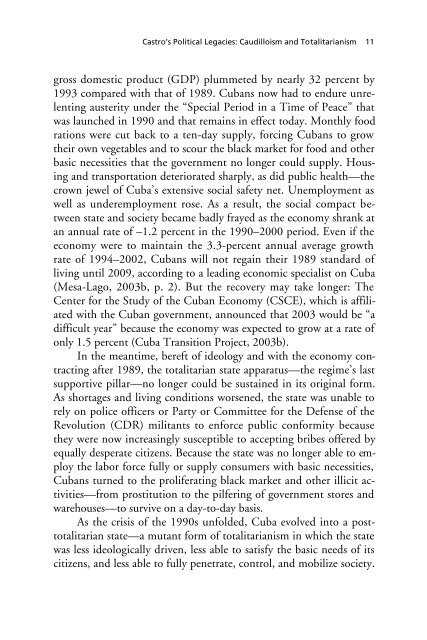Cuba After Castro - RAND Corporation
Cuba After Castro - RAND Corporation
Cuba After Castro - RAND Corporation
Create successful ePaper yourself
Turn your PDF publications into a flip-book with our unique Google optimized e-Paper software.
<strong>Castro</strong>’s Political Legacies: Caudilloism and Totalitarianism 11<br />
gross domestic product (GDP) plummeted by nearly 32 percent by<br />
1993 compared with that of 1989. <strong>Cuba</strong>ns now had to endure unrelenting<br />
austerity under the “Special Period in a Time of Peace” that<br />
was launched in 1990 and that remains in effect today. Monthly food<br />
rations were cut back to a ten-day supply, forcing <strong>Cuba</strong>ns to grow<br />
their own vegetables and to scour the black market for food and other<br />
basic necessities that the government no longer could supply. Housing<br />
and transportation deteriorated sharply, as did public health––the<br />
crown jewel of <strong>Cuba</strong>’s extensive social safety net. Unemployment as<br />
well as underemployment rose. As a result, the social compact between<br />
state and society became badly frayed as the economy shrank at<br />
an annual rate of –1.2 percent in the 1990–2000 period. Even if the<br />
economy were to maintain the 3.3-percent annual average growth<br />
rate of 1994–2002, <strong>Cuba</strong>ns will not regain their 1989 standard of<br />
living until 2009, according to a leading economic specialist on <strong>Cuba</strong><br />
(Mesa-Lago, 2003b, p. 2). But the recovery may take longer: The<br />
Center for the Study of the <strong>Cuba</strong>n Economy (CSCE), which is affiliated<br />
with the <strong>Cuba</strong>n government, announced that 2003 would be “a<br />
difficult year” because the economy was expected to grow at a rate of<br />
only 1.5 percent (<strong>Cuba</strong> Transition Project, 2003b).<br />
In the meantime, bereft of ideology and with the economy contracting<br />
after 1989, the totalitarian state apparatus––the regime’s last<br />
supportive pillar––no longer could be sustained in its original form.<br />
As shortages and living conditions worsened, the state was unable to<br />
rely on police officers or Party or Committee for the Defense of the<br />
Revolution (CDR) militants to enforce public conformity because<br />
they were now increasingly susceptible to accepting bribes offered by<br />
equally desperate citizens. Because the state was no longer able to employ<br />
the labor force fully or supply consumers with basic necessities,<br />
<strong>Cuba</strong>ns turned to the proliferating black market and other illicit activities––from<br />
prostitution to the pilfering of government stores and<br />
warehouses––to survive on a day-to-day basis.<br />
As the crisis of the 1990s unfolded, <strong>Cuba</strong> evolved into a posttotalitarian<br />
state––a mutant form of totalitarianism in which the state<br />
was less ideologically driven, less able to satisfy the basic needs of its<br />
citizens, and less able to fully penetrate, control, and mobilize society.

















